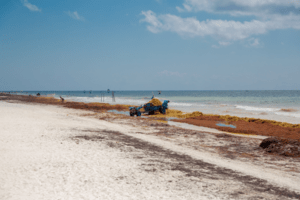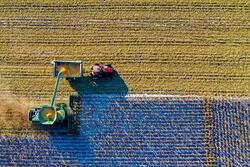Seaweed: What's Judaism Got to Do with It?
This year, when my parents asked me what I wanted as a graduation present, I immediately knew the answer: A trip to St. Thomas. My family had been faithfully visiting the island starting before I was born, and until I was eleven, when the logistics and expenses made it too difficult to continue. My baby naming was at the Hebrew Congregation of St. Thomas: the oldest synagogue building in continuous use under the American flag, the second oldest in the Western Hemisphere, and one of only five synagogues in the world with sand on its floor.
I slept through the night for the first time at six-weeks-old to the sound of the Carribean waves; my little brother learned to dance to island music in bars with locals we grew close with over the years. Throughout my childhood, St. Thomas was our home away from home: a place where we could sit sweating on sandy white beaches, snorkel among schools of tropical fish, and look up at the stars. On those trips, I often thought about how lucky we were to be able to visit such a beautiful and peaceful place.
Fortunately, my parents obliged my request to return to St. Thomas, and we flew south in June. Walking down the stairs off the plane onto the tarmac was an emotional experience—homecomings often are. Much of the island was familiar to us: the big blue grocery store next to the airport, Donkey Hill, and those beautiful Bougainvillea flowers. However, the thick belts of sargassum seaweed on many of the island’s renowned beaches were new.
Sargassum is a naturally occurring aquatic plant that floats in the Atlantic, particularly in the Sargasso Sea, and grows in scattered patches. Under normal conditions, floating sargassum is a thriving ecosystem. It acts as a habitat and food source for sea turtles, crabs, fish, and marine birds. Usually, small quantities of sargassum drift naturally into the Caribbean from the northern Sargasso Sea. But in the last seven years, sargassum from the north equatorial recirculation region (NERR) has begun inundating beaches from Africa to Florida with thick belts of seaweed. When the seaweed grows too thick, it clumps into dense, tangled mats that are so expansive and impenetrable that surface-breathing aquatic animals can’t break through.
These mass accumulations of seaweed desolate marine and coastal ecosystems by preventing sunlight from reaching coral reefs and seagrass beds. When the seaweed dies, its decay both depletes the water of oxygen and releases hydrogen sulfide. The result is the rapid degradation of seagrass beds, mangroves, coral reefs, and other shallow ecosystems.
The hydrogen sulphide gas released by the seaweed is dangerous and destructive in large amounts. It can cause headaches, dizziness, nausea, and even asthma. According to the US Environmental Protection Agency, it can also cause “rapid and extensive damage to concrete and metals.”
Over drinks and french fries, I talked with a boat captain about the detrimental effects of hydrogen sulphide: Many fishing boats around the islands have live bait fish on them. When the fishing boats pull into marinas and harbours, the small fish die almost instantly from the strong gas from the seaweed. The captain also told us that the stereo on his boat broke and turned from silver to black as a result of the gas emissions.
Since Hurricane Irma, tourism in St. Thomas has significantly decreased. While many resorts sustained minor damages, the majority of the island’s hotels were demolished. Today, the island is still only at 30 percent tourist capacity, meaning the economy took a big hit. Irma resulted in the dramatic loss of sand on St. Thomas beaches, and the mass accumulation of sargassum on the shorelines reduces the amount even more. Often, during the seaweed removal process, sand is taken off the beaches, compounding the loss from Hurricane Irma. The Caribbean Council says, “Although there are no reports of visitor cancellations, the hospitality industry across the region is concerned about the seaweed’s unsightly appearance, visitor complaints, the cost of mechanical removal, and the possibility of reputational damage.”
So why is this seaweed washing up on beaches around the world? The answer: human-caused climate change and pollution.
Evidence points to excessive nutrients from agricultural fertilizers and pollution, increasing nutrient flows from the Congo and Amazon Rivers, and increasing sea surface temperatures caused by climate change as the sources of the mass seaweed accumulation. In the Amazon Rainforest, continued deforestation by farmers and cattle ranchers has led to an upsurge in the amount of nutrient pollution flowing out to the ocean from the Amazon River when it rains. This process is called eutrophication, and means that those excessive nutrients also inadvertently feed naturally growing sea plants.
Jewish tradition teaches us to care for our planet, preserve our natural resources, and generate new resources for coming generations. We are encouraged l'avdah ul'shamrah, “to till and to tend,” to preserve the planet G-d loaned to us. The Torah commands (as does the tattoo on my arm), “Justice, justice shall you pursue” (Deuteronomy 16:20). Our environmental policies must also be just; the countries responsible for climate change—developed countries—should be those responsible for finding a solution. Because our sacred texts teach that humankind has an obligation to improve the world for future generations, I believe that reducing our waste, investing in companies that don’t pollute, and supporting behaviors and policies that encourage conservation are in keeping with Jewish tradition.
Hopefully I won’t need to wait another seven years before going back to St. Thomas. But no matter how long the wait is, I know that I’ll be fighting from wherever I am to protect the tiny island and our beautiful Earth for future generations.








Dear Emma,
Thanks for your poetic and powerful essay, including important information about the place of naturally occurring seaweed and how its overabundance is killing off the last of the surviving marine life....I hope you follow this article up with listing the groups you work with and fundraise for that heal the ocean. True Jews understand that Knowledge Is Power and Responsibility, and that we are given mitzvoth from God to steward the Earth responsibly.
I work to protect and restore our last 4% of Ancient, Pristine Redwood Forest on the Pacific Northwest by starting a Music Production Co. whose purpose is to enact TIKKUN OLAM by producing Inspiring Music and fundraising for Save the Redwoods League. Forests drive the Water/Air cycle for Planet Earth. Ancient, pristine Redwood Forest sequesters the most carbon and produces the most oxygen.
Please stay in touch with me. If you write, I will send you an original song, "SEQUOIA," which has the voices of our last birds, our last squirrels, wind and waves flowing through streams of Music. And you can find out about the Concerts for the Forest, an ongoing series of events that can and will Heal the World. It is possible for you to be a Visionary Speaker at one of the events.
Looking forward to hearing from you, and learning more about what you are doing to restore the ocean to the original state God gave it to us. The miracle of Life on Earth is that anything is possible, anytime, anywhere and that we become what we contemplate and act upon.
Shalom. May Peace, Love, Courage and Common Sense prevail,
Loriel Golden
TIMELESS SOUND
Concerts for the Forest
(707) 861~3797
I
You crushed it Emma